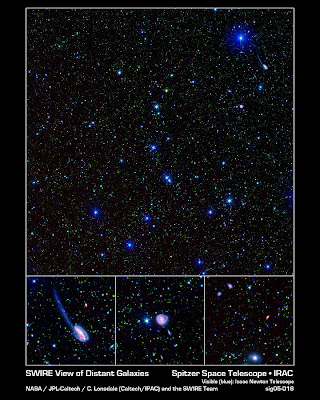
Credit: NASA/JPL-Caltech/C. Lonsdale (Caltech/IPAC) and the SWIRE Team
Written by Linda Vu, Spitzer Science Center
When it comes to giving birth, galaxies don't seem to have a "ticking biological clock." In fact, observations from NASA's Spitzer Space Telescope show that old galaxies were the biggest producers of new stars when our universe was half of its current age of 13.6 billion years.
"The idea that galaxies might form their stars in different generations at different times is an old one... What our work proves is that this is the 'typical' behavior of the most luminous infrared galaxies between five and eight billion years ago," says Dr. Karina Caputi, of the Institute of Astronomy ETH Hoenggerberg, in Zurich, Switzerland.
Infrared galaxies are extremely dusty, and most are furiously forming new stars. Astronomers suspect that the source of the galaxy's infrared glow comes from the warm dust around newborn stars. Using Spitzer data, Caputi and her colleagues identified approximately 600 of the brightest infrared galaxies within eight billion light-years of Earth.
"The Spitzer data allowed us to estimate how luminous these galaxies were at infrared wavelengths and, how many stars were forming per unit time. The most luminous infrared galaxies were forming stars at a rate equivalent to a few tens to several hundreds of Suns per year," says Caputi.
Once team members identified the galaxies, they used data from the ground-based observations from the European Southern Observatory's Very Large Telescope (VLT), in Chile, to learn about the stellar population of these infrared galaxies.
"For most of the galaxies in our study, the VLT data revealed an older population of stars mingling with newborn stars. This indicates that the galaxies are 'old,' and undergoing a new 'burst' of star formation," says Caputi.
Team members suspect that the older stellar population was responsible for filling the infrared galaxies with dust. This dust eventually absorbed ultraviolet light from the new generation of stars, and re-emitted the absorbed energy in infrared, giving the galaxies their infrared shine.
In addition, the scientists found a 10 to 100 million-year lag between when the starbursts began, and when the galaxy got its brilliant infrared glow.
"We suspect that it must take that long for the dust to absorb the ultraviolet-light that is emitted by young stars, and re-emit it in the infrared," says Caputi, who notes that this research will help astronomers better understand how galaxies develop over time.
A paper on the topic was published in the June 2008 issue of Astrophysical Journal. It incorporated data from the Spitzer's S-COSMOS Legacy Project, led by Dr. David Sanders, of the University of Hawaii, Honolulu. And, VLT data collected by Dr. Simon Lilly, of the Institute of Astronomy ETH Hoenggerberg, in Zurich, Switzerland.
A SWIRE Picture is Worth Billions of Years
These spectacular images, taken by the Spitzer Wide-area Infrared Extragalactic (SWIRE) Legacy project, encapsulate one of the primary objectives of the Spitzer mission: to connect the evolution of galaxies from the distant, or early, universe to the nearby, or present day, universe.
The larger picture (top) depicts one-tenth of the SWIRE survey field called ELAIS-N1. In this image, the bright blue sources are hot stars in our own Milky Way, which range anywhere from 3 to 60 times the mass of our Sun. The fainter green spots are cooler stars and galaxies beyond the Milky Way whose light is dominated by older stellar populations. The red dots are dusty galaxies that are undergoing intense star formation. The faintest specks of red-orange are galaxies billions of light-years away in the distant universe.
The three lower panels highlight several regions of interest within the ELAIS-N1 field.
The Tadpole galaxy (bottom left) is the result of a recent galactic interaction in the local universe. Although these galactic mergers are rare in the universe's recent history, astronomers believe that they were much more common in the early universe. Thus, SWIRE team members will use this detailed image of the Tadpole galaxy to help understand the nature of the "faint red-orange specks" of the early universe.
The middle panel features an unusual ring-like galaxy called CGCG 275-022. The red spiral arms indicate that this galaxy is very dusty and perhaps undergoing intense star formation. The star-forming activity could have been initiated by a near head-on collision with another galaxy.
The most distant galaxies that SWIRE is able to detect are revealed in a zoom of deep space (bottom right). The colors in this feature represent the same objects as those in the larger field image of ELAIS-N1.
The observed SWIRE fields were chosen on the basis of being "empty" or as free as possible from the obscuring dust, gas, and stars of our own Milky Way. Because Earth is located within the Milky Way galaxy, there is always a screen of Milky Way objects blocking our view of the rest of the universe. In some places, our view of the larger universe is less obscured than others and for the most part is considered "empty." These are prime observing spots for astronomers interested in studying objects beyond the Milky Way. ELAIS-N1 is only one of six SWIRE survey fields. The full survey covers 49 square degrees of the sky, equivalent to the area covered by about 250 full moons.
The SWIRE image is a 3-channel false-color composite, where blue represents visible green light (light that would appear to be blue/green to the human eye), green captures 3.6 microns, and red represents emissions at 8 microns.
Interesting Note: From the Earth the SWIRE image (top image) can be seen in one square degree of sky, or a patch of sky that is approximately the size of a pea held out at arms length.